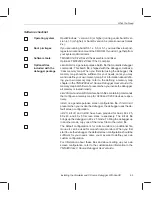
Step 2: Setting Up the Debugger Environment
1-5
Installing the Simulator and C Source Debugger With DOS
1.3
Step 2: Setting Up the Debugger Environment
To ensure that your debugger works correctly, you must identify the items that
are listed in Table 1–1. You can specify this information either in an initializa-
tion batch file (see page 1-6) or in your
autoexec.bat file (see page 1-7).
Table 1–1. Debugger Environment Variables
To identify . . .
Use a statement with this format . . .
Directory with executable files for
the C source debugger
PATH=
drive :\ directory
Directory with debugger data files,
such as
init.cmd and init.clr
SET D_DIR=
drive :\ directory
Directory with the program source
files that you want to debug
SET D_SRC=
drive :\ directory
Address of the emulator port on
your PC and other options that you
SET D_OPTIONS= [
object filename] [options ]
your PC and other options that you
want to use every time that you
invoke the debugger
[
object filename]
Names the file that you want to load every time that
you invoke the debugger.
invoke the debugger
[
options]
Indicates the port address and other options; for
more information, see the
TMS320C2xx C Source
Debugger User’s Guide.
–p
port address
Identifies the emulator port on your PC:
378 default port address for the XDS510PP (LPT1
on most PCs); to verify the address of the
printer port where you connected the
XDS510PP, see your PC documentation.
240 default port address for the XDS510; for more
information, see the
XDS51x Emulator Instal-
lation Guide.
–b
Selects a screen size of 80 characters by 43 lines
(EGA or VGA)
–bb
Selects a screen size of 80 characters by 50 lines
(VGA only)
–font
height
Uses the Windows Terminal font closest in point
size to the specified height
–i
pathname
Identifies additional directories
–mv
version
Specifies the memory map to use with the simulator
–profile
Allows you to enter the profiling environment
–s
Loads only the symbol table for a named object file
–t
filename
Identifies a new initialization file
–v
Loads the object code with a minimal symbol table
Note:
When you invoke the debugger, you can include –x on the command line to override any D_OPTIONS in the initialization
file or in your autoexec.bat file.
Summary of Contents for SCOUTTRAINER25
Page 1: ...TMS320C2xx Simulator Getting Started Guide 1996 Microprocessor Development Systems ...
Page 2: ...Printed in U S A April 1996 D412015 9741 revision SPRU176 ...
Page 3: ...TMS320C2xx Simulator Getting Started Guide SPRU176 April 1996 Printed on Recycled Paper ...
Page 6: ...vi ...
Page 18: ...1 10 ...
Page 44: ...Index 6 ...




























